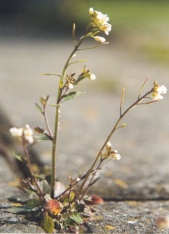Circadian clocks
Circadian clocks coordinate processes across the day, but they can also be used to measure daylength (photoperiod) allowing for coordination of seasonal development. There is a considerable amount known about the circadian oscillator itself, but we know far less about how the oscillator connects to daily and seasonal biological processes. We study this question in the model plant Arabidopsis because it has easily observable circadian physiology, and transgenics that express visual reporters for daily and seasonal rhythms. These tools make plants a preeminent system for biological timing research where fundamental principles have been discovered.
My laboratory investigates two broad questions about biological timing in plants:
1) How does the circadian clock utilize protein degradation to impart rhythmicity on biological processes?
Circadian clock systems rely on regulated protein degradation for accurate 24-hour timing, but genetic redundancy has hampered the discovery of protein degradation mechanisms that control circadian clocks. To add
ress this, we developed the “decoy” approach and deployed the strategy en masse. This work has greatly expanded our knowledge of how the circadian clock recruits the ubiquitin proteasome system to impart rhythmicity on biological processes.

2) How do plants measure daylength to control seasonal development and physiology?
For the majority of the last century studies of photoperiodism have focused on flowering. We discovered a new photoperiodic timekeeper that utilizes the seasonal control of metabolism to control growth and other important seasonal processes. This showed that plants have multiple photoperiod measurement systems working in parallel to independently coordinate developmental processes across the year. This finding changes our fundamental view of seasonal timing showing that organisms can perceive a variety of different daylengths in discrete ways to predict seasonal changes in the environment and optimize fitness accordingly. This is especially important in the context of the climate emergency which is disconnecting photoperiod from the climatic variables that it predicts, namely temperature and water availability.

To address questions about daily and seasonal timing we use a variety of techniques that include genetics, biochemistry, molecular biology, transcriptomics and bioinformatics, and physiology. The decoy approach can be combined with affinity puriifcation and mass spectrometry to identify the targets and regulatory partners of E3 ubiquitin ligases. We also develop specialized lighting regimes that alter intensity, wavelength, and most importantly, timing. These light regimes allow us to test how plants distinguish between different types of daylengths.
The work that we perform is translatable to any research system, but plants are currently the best model for our type of research. In the future, we plan to test the decoy approach and explore seasonality in a variety of plant species. This will help make our most important crop species robust to the rapid climatic changes that are happening due to fossil fuel combustion.